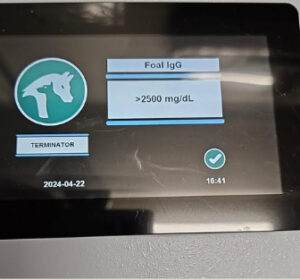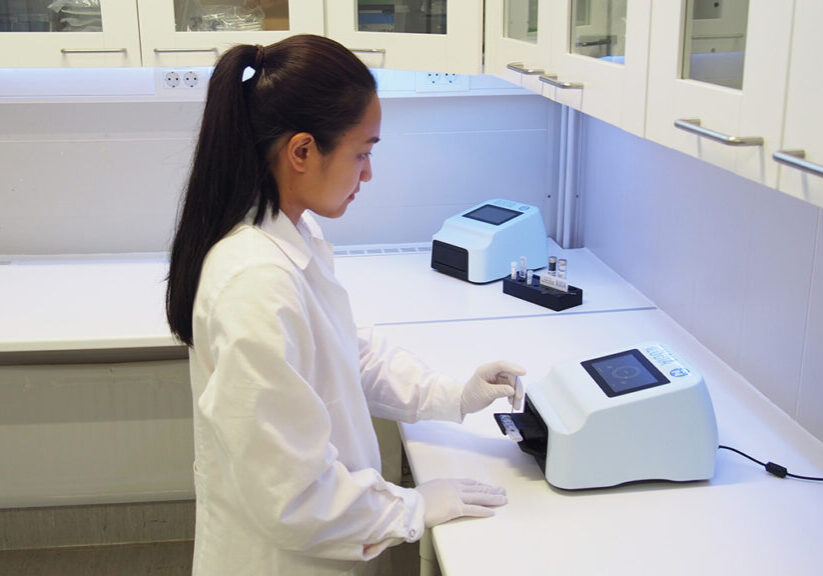Rapid testing supports premium equine health.
- Obtain critical health data within minutes, enabling swift decisions and immediate care for your horse.
- Reduce stress for both horses and their owners with quick, hassle-free diagnostics directly at the stable.
- Rapid testing enables the detection of early warning signs, allowing for proactive measures.
- Keep your horse in peak performance by monitoring key health indicators regularly.
True quantitative result in 6 minutes.
Diagnostics for Equine Health
Serum Amyloid A (SAA) test provides nearly real-time detection of infection and inflammation.
Fibrinogen test aids in assessing infection and inflammation status in horses.
Foal IgG test measures IgG antibody levels in newborn foals and aids in assessing failure of passive transfer of immunity (FPT, FTPI).
Rapid Results - On-Site.
True Quantitative Result
The test provides a precise numerical value of the analyte in the sample. This aids in making informed treatment decisions and allows for accurate monitoring of the treatment's effectiveness.

In 6 Minutes
The test provides results in just six minutes, enabling rapid decision-making and immediate treatment. This saves time and improves treatment outcomes.

On-Site
The test can be performed directly at the stable or clinic, reducing the need to send samples to a lab. This allows for faster diagnosis and treatment without delays.

Is your foal protected? Find out how to measure antibodies at the stable.
In this video, a veterinarian performs a health examination on a newborn foal and measures its antibody levels.




Veterinarians and breeders from various countries share their experience with the Foal IgG test – performed directly at the stable using the LUCIA Vet analyzer, as shown in the images above.
Understand Equine Inflammation On-site with SAA & Fibrinogen.
Monitoring inflammation in horses is more informative when measuring both SAA and fibrinogen. Their complementary dynamics provide insights into the stage and type of the inflammatory response, helping veterinarians make timely, informed decisions.
Expert Insight
“SAA and fibrinogen together provide a much clearer picture of how inflammation is developing in the horse. Their different response speeds help distinguish early, acute inflammation from ongoing or training-related changes.”
— Dr. Kareen Heineking Camacho, equine veterinarian & health expert

Key interpretations:
Early vs. ongoing inflammation
- SAA rises rapidly within hours → indicates new, acute inflammation
- Fibrinogen rises more slowly (24–72 h) → reflects ongoing or developing inflammation
Example:- SAA ↑, fibrinogen normal → very early acute inflammation
- SAA ↑, fibrinogen ↑ → progressing or sustained inflammation
Infection vs. training-related changes
Infection vs training-related changes
- SAA generally rises only in infection
- Fibrinogen may rise slightly after exercise
Example:- Fibrinogen ↑, SAA normal → likely exercise-related
- SAA ↑ → likely infection-driven
Assessing severity of inflammation
Assessing severity of inflammation
- Strong SAA increase typical of bacterial infections
- Fibrinogen rises more gradually
- Combined markers help visualize the intensity and stage of the inflammatory process
Video: Performing the Labmaster LUCIA™ equine SAA test – a simple rapid test for quantitative determination of serum amyloid A (SAA) in horses.
Easy test procedure offers quick access to health information.
Rapid or point-of-care (POC) veterinary diagnostics reduces costs and and facilitates the early steps of beginning treatment. Labmaster's tests are based on a small whole blood sample and produce a quantitative result in 6 minutes.
Tests can be performed when and where needed, such as the veterinarian's office, care facility, animal clinic or stable.
The test procedure is easy, as you can see on this video of performing the Labmaster LUCIA™ Equine SAA test.
We are happy to arrange an online demonstration of the LUCIA Vet platform.
What our Customers Say:


At Salsbro Stud in Sweden, the test is now a routine examination for every foal.
"Labmaster’s rapid test works perfectly – it is simple, reliable, and provides accurate values. For us, it’s invaluable."
– Cecilia Kåberg, Stud Manager
Salsbro Stuteri, Vretstorp, Sweden
Haras du Saubouas, located in the Gers region of France, uses Labmaster’s Foal IgG test.
"Very good device, easy to use, perfect!"
– Paul Basquin
Haras du Saubouas, Lagraulet-du-Gers, France

Photo: Harri Koivunen Racing

Photo: Larva-Jussila
After transportation, a horse appeared to be in poor general condition. A rapid SAA test performed at the stable revealed severe inflammation – treatment could begin immediately.
"I appreciate the quick access to reliable data. The tests also help us easily monitor the effectiveness of the treatment."
– Heidi Vuori
Harri Koivunen Racing, Finland
We now use the Labmaster LUCIA™ Vet analyzer at the stable to measure SAA in horses and IgG in foals – with numerical results available in just a few minutes.
"Valuable information, especially during foaling season – and with no waiting time."
– Riikka Takaneva
Larva-Jussila, Finnish horse breeder

Efficient products based on Finnish technology.
Labmaster’s diagnostic products are based on proprietary technology that is accurate, fast, and cost-effective. This makes our products an efficient solution for point-of-care veterinary diagnostics. Our technology delivers fast and precise results, facilitating timely decision-making and early treatment of animals.
We are constantly developing new tests for our Labmaster LUCIA™ veterinary product family to meet the growing needs of veterinary medicine. All of our tests are performed with the Labmaster LUCIA™ Vet table-top analyzer, a CE-marked device ensuring the highest quality and safety.
More about the benefits of point-of-care (rapid) testing of inflammation for equine health.
Witkowska‐Piłaszewicz et al. (2019): Discusses the application of SAA in detecting inflammation and infection early in equine health, emphasizing its utility in reducing complications through timely diagnosis.
Bullone et al. (2015): Examines biomarkers like SAA and their role in identifying inflammatory airway diseases in horses, highlighting their sensitivity to early-stage inflammation.
Jacobsen et al. (2023): Reviews SAA's use in equine surgery and medicine, emphasizing its importance in early intervention to manage subclinical infections.
Belgrave et al. (2013): Analyzes the reliability of SAA as a diagnostic tool across species, with a focus on its quick response to inflammatory stimuli in equines.
Hobo et al. (2007): Investigates the utility of SAA for monitoring clinical conditions like bacterial pneumonia in horses, reinforcing its importance in respiratory disease management.
Pfäfflin & Schleicher (2009): Reviews the significance of acute-phase proteins like SAA in point-of-care testing and their impact on treatment efficiency.
Cray, C., Zaias, J., & Altman, N. H. (2009): A comprehensive review of acute-phase proteins, including SAA, across species, establishing the scientific basis for their diagnostic utility in veterinary contexts.
Eckersall, P. D., & Bell, R. (2010): This paper extensively reviewed acute-phase proteins in veterinary settings, detailing the role of SAA in inflammation and its potential for POC diagnostics.

Tony Wahlroos, CEO
tel. +358 40 052 7905
Ready to find out more?
We are happy to share more information with you about us and our products.
Request an online presentation on the workflow of our LUCIA Vet platform!



